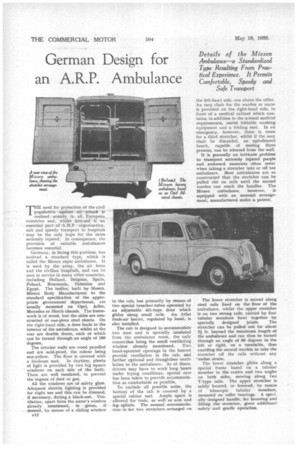German Design for an A.R.P. Ambulance
Page 46

If you've noticed an error in this article please click here to report it so we can fix it.
Details of the Miesen Ambulance—a Standardized Type Resulting From Practical Experience. It Permits Comfortable, Speedy and Safe Transport
need for protection of the civil rpopulation against . air 'attack is
realized acutely in all European countries and, whilst first-aid is an essential part of A.R.P. organization. safe and speedy transport to hospitals may be the only hope for the more seriously injured. In consequence, the provision of suitable ambulances becomes essential.
Germany, in facing this problem, has evolved a standard type, which is called the Miesen super ambulance, It is used by the army, the air force and the civilian hospitals, and can be seen in service in many other countries, including Holland, Belgium, Spain, Poland, Roumania, Palestine and Egypt. The bodies, built by Messrs. Miesen Body Manufacturers to the standard specification of the appropriate government department, are usually mounted on Opel, Adler, Mercedes or Horch chassis. The framework is of wood, but the sides are constructed of one-piece steel sheets. On the right-hand side, a door leads to the interior of the ambulance, whilst at the rear are dot:11)/e doors, each of which can be turned through an angle of 180 degrees.
The interior walls are wood panelled and are acid-proof, the colour being sun-yellow. The floor is covered with a linoleum mat. In daytime, plenty of light is provided by two big square windows on each side of the body. These are well insulated, to prevent the ingress of dust or gas.
All the windows are of safety glass. Adequate electric lighting is provided for night use and this can be dimmed, if necessary, during a black-out. Ventilation, apart from the nurse's window already mentioned, is given, if desired, by means of a sliding window
e12 in the cab, but primarily by means of two special breather-tubes operated by an adjustable slit-type door which glides along small rails. An Atlas fresh-air heater, regulated by hand, is also installed.
The cab is designed to accommodate two men and is specially insulated from the ambulance room, the only connection being the small ventilating window already mentioned. Two hand-operated openings in the bonnet provide ventilation in the cab, and further optional and draughtless ventilation to the ambulance. As at times, drivers may have to work long hours under trying conditions, special care has been taken to provide accommodation as comfortable as possible.
To exclude all possible noise, the bottom of the cab is covered by a special rubber mat. Ample space is allowed for tools, as well as arm and leg splints. The normal accommodation is for two stretchers arranged en the left-hand side, one above the other. An easy chair for the warden or nurse is provided on the right-hand side, in front of a medical cabinet which contains, in addition to the normal medical requirements, useful foldable washing equipment and a folding seat. In an emergency, however, there is room for a third stretcher, whilst if the easy chair be discarded, an upholstered bench, capable of seating three persons, can be released from the wall.
It is generally an intricate problem to transport seriously injured people and awkward moments often occur when taking a stretcher into or off tile ambulance. Most ambulances are so constructed that the stretcher can be pulled out on rails until the second warden can reach the handles. The Miesen ambulance, however, is equipped with an unusual arrangement, manufactured under a patent.
The lower stretcher is moved along steel rails fixed on the floor of the ambulance, whilst the upper stretcher is on two strong rails, carried by four tubular members fixed together by specially designed joints. The stretcher can be pulled out for about 21 ft. beyond the maximum length of the ambulance and can then be turned through an angle of 90 degrees to the left or right, on a turntable, thus enabling the second warden to take the stretcher off the rails without any 'undue strain.
The lower stretcher glides along a special frame based on a tubular member in the centre and two angles on both sides, moving along two T-type rails. The upper stretcher is safely located, or lowered, by means of telescopic tubular members, mounted on roller bearings. A specially designed handle, for lowering and lifting the stretcher, gives additional safety and gentle operation.




















































































